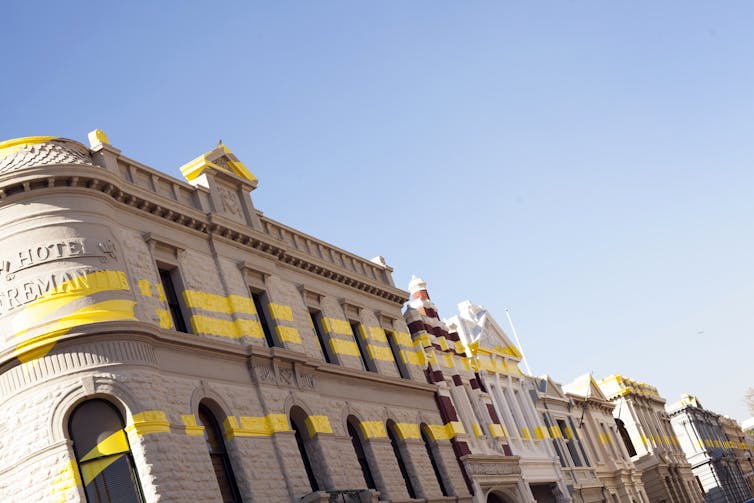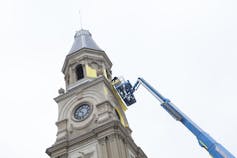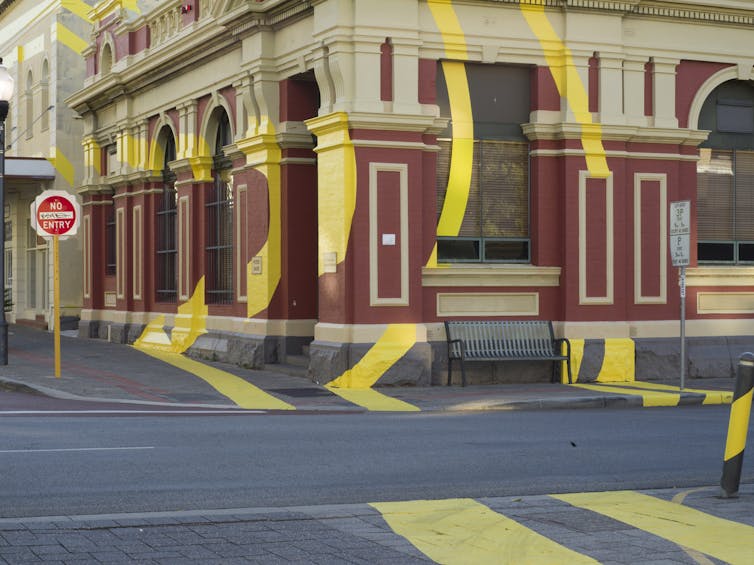Fremantle's High Tide festival: wonder and illusion as artists turn streets into stages
- Written by Ted Snell, Professor, Chief Cultural Officer, Cultural Precinct, University of Western Australia
Fremantle proudly proclaims itself a “city for artists”, and while that has been a somewhat hollow boast in recent years, there is evidence of its former cultural vibrancy returning. The Fremantle Arts Centre, ArtSource and Spare Parts Puppet Theatre have held the fort while other venues and organisations have collapsed into the back hole of Australia Council funding cuts, but the opening of the High Tide festival of site-responsive art raises hopes for a return to the city’s artistic leadership role.
Announced as the inaugural event of a new Fremantle Biennale, High Tide brings together a group of artists who respond to and work with the history, landscape, and community that define a city’s sense of place.
Within the West End, these artists have created works within, on and around its buildings and public spaces. While many of the public murals currently colonising walls around the country infiltrate the urban landscape, the works created for High Tide grow from it and act as a trigger to re-examine the environment they inhabit. They are a prompt to re-think its history and a stimulus to re-assess preconceptions of place.
Felice Varini has been working on major urban installations around the world since 1978, so he was a natural choice as keynote artist for this festival. He began his career designing for the theatre, and after refocusing his creative energies as a painter, his ambitions expanded from the confines of a rectangular canvas to tackle architectural interiors and eventually expanded urban environments.
His latest work for High Tide returns full-circle to explore the world of illusion, light, magic, and shadow that was at the centre of his theatrical practice. His painting in the heart of Fremantle transforms High Street into a stage, which we are invited to activate. Wandering down towards the Roundhouse at the end of the street one enters a space of surprise and wonder, where shards of yellow paint interact with the buildings and are enlivened by the coloured garments of fellow performers taking an afternoon stroll.
 Felice Varini, Arcs d'Éllipses (2017)
High St (from Round House to Town Hall), Fremantle. Installation view High St.
James Whineray
Felice Varini, Arcs d'Éllipses (2017)
High St (from Round House to Town Hall), Fremantle. Installation view High St.
James Whineray
Varini’s Arcs D’Ellipses is captivating, in every sense. Not only does it attract attention but it beguiles and charms with its looping, yellow arches that intertwine through the buildings of the old port town. The effect is mesmerising. It demands sustained engagement and encourages return visits to confirm our first impressions.
 Felice Varini, Arcs d'Éllipses (2017) Installation view Town Hall.
James Whineray
Felice Varini, Arcs d'Éllipses (2017) Installation view Town Hall.
James Whineray
The painting is premised on the notion of a fixed point of view, from which we read the six yellow arches framed and contained by the streetscape. Standing on the stairs that lead up to the Roundhouse at the end of High Street is the sweet spot where everything comes together with startling clarity. All the fragments of yellow that seem arbitrarily painted on the walls, footpath, and signage you have just walked past, coalesce into a brilliantly composed series of golden arches that literally pop up from the street and seem to hover magically in front of you.
With permission from the City Council, Varini and curator Tom Müller blacked out the entire West End for an evening and projected the image of the arches onto the buildings, while a team of volunteers atop Cherry Pickers carefully drew the outline of the arches wherever they struck a solid surface.
Then over a four-week period, Varini and his team applied very thin aluminum sheeting that wrapped around these surfaces, adhering to each area, no matter how small. The resulting yellow fragments are embedded in the streetscape and provide markers to discovery of architectural features, forgotten elements and surprising juxtapositions.
 Felice Varini, Arcs d'Éllipses (2017)
High St (from Round House to Town Hall), Fremantle. Installation view University of Notre-Dame.
James Whineray
Felice Varini, Arcs d'Éllipses (2017)
High St (from Round House to Town Hall), Fremantle. Installation view University of Notre-Dame.
James Whineray
While the punch line is the Instagram shot from the Roundhouse stairs where the six arches spiraling back to the Town Hall are clearly visible, Arcs D’Ellipses delivers so much more. Like many of the other works in High Tide, it makes the viewer an active participant in the event.
Zora Kreuzer’s Arcade is deceptively simple. Appropriating the façade of the old Liebler Building she has chosen a palette of fluoro hues to paint to create a rainbow spectrum of spaces in the former arched window cavities. Not only do they re-energise the building but instantly she has created a photo booth for the thousands of visitors streaming through the historic site.
Trevor Richard’s Lowdown installation, painted directly onto the tarmac of Mouat Street, plays similar games with geometry that shifts our perception of the urban environment.
 Tom Mùller, Uprising (2017)
Installation view Round House, Fremantle.
James Whineray
Tom Mùller, Uprising (2017)
Installation view Round House, Fremantle.
James Whineray
Combined with Jacobus Capone’s poignant Heartsstone video, made in homage to his boatbuilding grandfather and located in the J Shed, Thomas Müller’s Uprising video in the Roundhouse, Jo Darbyshire’s projection onto the Port Authority building, Domenico de Clario’s durational performance and many more works spread throughout the city, High Tide reinforces the legitimacy of Fremantle’s epithet.
The High Tide Festival runs until 12 November 2017
Authors: Ted Snell, Professor, Chief Cultural Officer, Cultural Precinct, University of Western Australia



